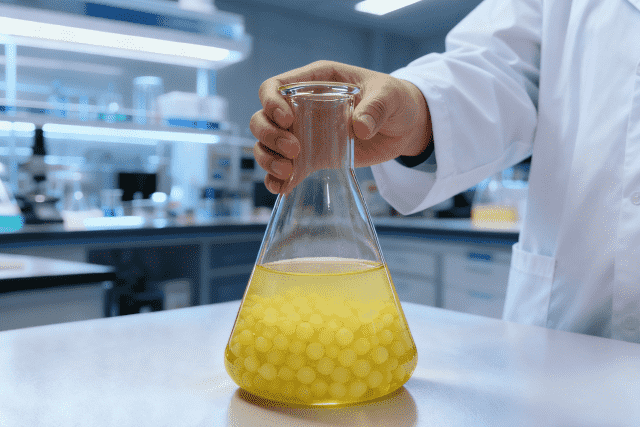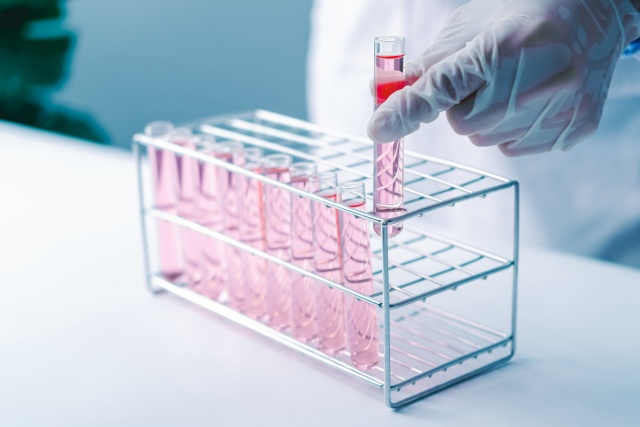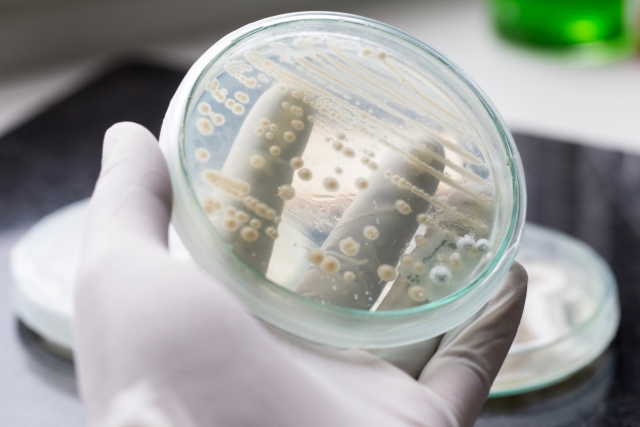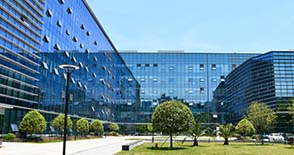December 18, 2019
By Yinqiang
Nitrogen sources refer to nutrients that make up the source of nitrogen in microorganism and its metabolites. Commonly used nitrogen sources can be divided into two categories: inorganic nitrogen sources and organic nitrogen sources. Inorganic nitrogen sources include ammonium sulfate, nitrate, ammonia and urea, and organic nitrogen sources include soybean meal, peanut meal, cottonseed meal, corn pulp, peptone, yeast extract and fish meal. Generally speaking, inorganic nitrogen sources only contain single composition which can be quickly assimilated but organic nitrogen sources have the following characteristics:
1. More complicated components and nutrients;
2. The rate of utilization by bacteria is different;
3. The utilization of amino acids in organic nitrogen sources by microorganisms is always selectiveness;
4. It is the crucial influencing factor of fluctuations in fermentation.
As the cultivation conditions of recombinant bacteria in the field of microbial fermentation are becoming increasingly severe, the requirements for culture media are becoming higher and higher. The search for natural, stable and applicable organic nitrogen sources has become a limiting factor in the development of fermentation industry. Under the demand of huge market, yeast-based organic nitrogen sources have emerged as the times require, and their natural, pollution-free, high stability and high applicability are accepted by the majority of fermentation enterprises.
1. Yeast-based organic nitrogen sources
Yeast-based organic nitrogen sources have high protein content (proteins account for more than 50% of the total try weight of yeast), contain 18 types of amino acids completely, as well as be rich in vitamins and minerals. That means, it is a kind of high quality organic nitrogen sources for microbial fermentation and cell culture. For example, yeast extract has been widely used as the raw materials for seed and fermentation media in a broad range of microbial fermentation applications. Actually, due to the growth needs of different strains, the products currently used in the field of biological fermentation mainly include: yeast powder (inactive dry yeast), autolyzed yeast, yeast extract and yeast peptone.
At present, the raw materials for producing yeast extract mainly come from brewer’s yeast and baker's yeast. Among them, baker’s yeast is the target of many researchers. Angel Yeast Co., Ltd. is the main player of baker’s yeast. However, some of yeast extracts also use spent brewer’s yeast as raw materials, such as the United States A-B beer company, Japan Sapporo, Kirin, etc. In Japan, dried spent brewer’s yeast is used to produce yeast extract.
2. Application of yeast-based organic nitrogen source in fermentation industry
(1) Fermentation of Lactic acid bacteria.
Lactic acid bacteria refers to a class of spore-free and Gram-positive bacteria whose main metabolites is lactic acid after fermenting sugars. Lactic acid bacteria is a kind of chemotrophic microorganism. Most lactic acid bacteria require complicated nutrients for their growth and acid production. Yeast extracts are rich in amino acids, peptides, amino acids, vitamins, nucleotides, etc., and are often used as key component of fermentation media for lactic acid bacteria. Zhang Ya and Leng Yifei used response surface methodology to optimize the growth medium of Lactobacillus acidophilus, in which the nitrogen source was yeast extract and the dosage was 8.682%. Using the optimized medium, the cell density can reach 16. 49 × 10^9 cfu / ml, which is 20.61% higher than the number of viable bacteria in classic MRS medium. Meanwhile the cost was reduced by 30%.
Hu Chengyuan selected 5 kinds of yeast extracts produced by famous enterprises for component content analysis, used them as nitrogen sources for the culture medium on 2 strains of Lactobacillus (Lacobacillus helveticus and Lactobacillus rhamnosus). The results showed that: in the cultivation of Lactobacillus helveticus, one type of Angel yeast extract was better than other three yeast extracts produced from Europe and US; In the cultivation of Lactobacillus rhamnosus, the performance of 4 types of yeast extracts was not obvious difference.
In the solid-state fermentation process of Chinese traditional liquor, lactic acid bacteria can promote Maillard reaction, improve the fermentation performance of liquor, and maintain the micro-ecological environment of liquor. Ding Haimei and Zhang Zhimin optimized the acid production medium of Lactobacillus casei by orthogonal experiments. The optimal organic nitrogen source in the obtained medium was casein peptone, beef extract and yeast extract, and the dosage of yeast extract was 0.5%.
(2) Steroid drugs.
Steroid hormones are a class of compounds containing a nucleus of cyclopentane polyhydrophenanthrene. These compounds are important for maintaining life, regulating sexual function, body development, immune regulation, skin diseases, and birth control. Steroid fermentation is a highly selective biological modification of steroid drugs by using microorganisms to produce enzymes. Steroid drug fermentation is catalyzed by cells. The amount of biomass is of great significance for steroid fermentation. Dr. Bie Songtao, an expert on steroid drug biotransformation, found that the culture of steroid drug-producing bacteria using a medium of yeast extract had a significantly better growth effect than that of other nitrogen sources, and its surface was dense, smooth and complete. The conversion rate of the substrate was also improved, and the conversion rate is basically stable at 90%. Li Jingwen, when studying the biotransformation method of steroid C1, 2 dehydrogenation, found that: 0.5% peptone, casein hydrolysate, yeast extract, urea, (NH4) 2 SO4, NH4NO3 was added to the culture medium of Arthrobacter simplex for research the effects of 6 different nitrogen sources on the enzyme production. The results showed that the enzyme activity was highest when yeast extract was used as the nitrogen source, reaching 16.28.
(3) Hyaluronic acid.
The hyaluronic acid fermentation strains mainly include streptococcus zooepidemicus and streptococcus equine. The TCA cycle of Streptococcus equicas is incomplete, and many essential amino acids and nucleotide precursors cannot be synthesized during the metabolism. Therefore, the nutritional requirements are severe and organic nitrogen sources that can provide a variety of necessary growth factors are necessary. Yeast extract is widely used in hyaluronic acid fermentation because it is rich in amino acids, peptides, amino acids, vitamins, nucleotides, etc. Many studies have shown that when yeast extract is used as a nitrogen source, compared with corn steep liquor and peptone as a nitrogen source, the strains grow well, the yield is high, the molecular weight of the product is large, and the down-stream processing cost of the fermentation broth is also lower.
Liu Yiran used genetic algorithms to optimize the hyaluronic acid-producing fermentation medium of Streptococcus equine, and finally optimized the selection of 6 medium components and 64 concentration levels with 40 experimental samples. The nitrogen source composition is: yeast extract 5.2g / L, peptone 8.4g / L, beef extract 8g / L. Zhao Huiming obtained through experiments that beef extract and yeast extract each accounted for 50% is the ideal nitrogen source composition of hyaluronic acid produced by Streptococcus zooepidemicus. Zhang Rongzheng also studied the nutritional conditions of hyaluronic acid produced by Streptococcus equines, and found that when a composite nitrogen source was used, the yeast extract and beef extract were mixed to form a composite nitrogen source with the ratio of 2: 1, the highest biomass and yield were obtained.
(4) Antibiotics
a. Oxytetracycline. Oxytetracycline is a kind of tetracycline antibiotic that can be used to treat rickettsial disease, including epidemic typhus, endemic typhus, rocky fever, tsutsugamushi, Q fever. Mycoplasma infection and chlamydia infection. According to the results of relevant research, 15% yeast extract (medium content) completely replaces 0.5% yeast powder (inactive yeast) for oxytetracycline fermentation, the titer of which increased 4.5%-17.8%, with a significant increase in production.
b. Midemicin. Medicin is a kind of 16-membered macrolide antibiotic. It is effective against gram-positive bacteria such as Staphylococcus aureus, pneumococcus, hemolytic streptococcus, epidermidis, anthrax, diphtheria, etc. Cercobacterium has strong antibacterial activity. Hubei Pharmaceutical Factory Research Institute compared the effects of yeast extract powder and yeast extract paste on medimycin fermentation by using shake flask. The results showed that 0.16% of yeast extract was better than 0. 25% yeast extract. Through 10 experiments with 2 strains, the average yield increased by more than 4%.
c. Avermectin. Avermectin is a group of macrolide compounds which is a kind of high-efficiency and extensive antibiotic insecticide and acaricide. Liu Xueyan found that the use of biological nitrogen to replace yeast powder and found that as the proportion of biological nitrogen (main part is yeast extract) increased to replaced yeast powder (inactive yeast) , the shake flask titer showed a gradual decline trend, and none of the controls had a higher shake flask titer. During the experiment, it was found that when the proportion of biological nitrogen replacing yeast powder gradually increased, the pH value gradually decreased. It can be seen that yeast powder (inactive yeast) is irreplaceable as a nitrogen source substance for avermectin fermentation.
d. Bandungomycin. Bandungomycin is a new type of agricultural antibiotic. Lin Birun selected nitrogen sources of animal, vegetable and microbial origin such as corn steep liquor, peanut cake flour, peptone, yeast extract, beef extract, etc. as the nitrogen source research object of the bandonomycin-producing bacteria. The test results showed that in peptone, yeast extract and beef extract are used as nitrogen sources can promote the growth and more hyphae was observed. Corn steep liquor, peanut cake powder, and beef extract as nitrogen sources are more suitable for the production of Bandungmycin producing bacteria, and more suitable for Bandung mold. Nitrogen sources for the production and growth of hormone producing bacteria are corn steep liquor and yeast extract.
(5) Biological preservatives
a. Natamycin fermentation. Natamycin-producing strain Streptomyces flavus, which requires rich nitrogen source, therefore yeast extract is an important component of its fermentation medium. Liang Shuwa studied the effects of different carbon sources, nitrogen sources, initial pH and DO of the medium on the growth and metabolism of the high-yield strain of Natamycin Streptomyces sp. In the experiment, yeast extract had a greater impact on the yield of natamycin. The better nitrogen sources were yeast extract, soybean oil and soybean peptone. They used the orthogonal experiment to determine the high-yield natamycin culture of the strain. The base formula is: 2% glucose, 3% corn starch, 0.5% yeast extract, 2% soy peptone. Li Yinghui found that complex nitrogen sources are often used in natamycin fermentation, yeast extracts are used as relative fast-released nitrogen source, and other organic nitrogen sources are used as slow-released nitrogen sources. Compounding at a certain ratio often can achieve the best results. .
Xu Guangyu Tianjin University of Science and Technology used a combination of Plackett-Burman method, steepest climbing test and response surface experiment (Box-Behnken design method) to synthesize natamycin from Streptomyces flavus The culture medium and fermentation conditions were optimized. The optimized medium composition was 50g / L glucose and peptone 19.5g / L, yeast extract 7g / L, the yield of natamycin was increased by 94% compared with before optimization.
b. Nisin. Streptococcus is a peptide substance produced by Streptococcus lactis, consisting of 34 amino acid residues. It is a natural food preservative with high efficiency, non-toxicity, safety and no side effects. Zhou Bin optimized the nisin culture medium by response surface methodology and found that the optimal nitrogen source for the culture medium was a mixed nitrogen source consisting of peptone, yeast powder and beef paste, and the most suitable yeast powder, peptone and beef paste When the concentration was 10g / L, 9g / L, and 5g / L, the titer of nisin was the highest, which could reach 1,440IU / mL.
(6) Xanthan gum. Xanthan gum, also known as xanthan gum, xanthan gum, and xanthomonas polysaccharide, is a widely used microbial extracellular polysaccharide produced by Xanthomonas campestris with carbohydrates as its main raw material. Lo Y M studied the glucose / yeast extract ratio (G / YE) in culture medium against Xanthomonas campestris under various fermentation modes (batch, two-stage batch and fed-batch fermentation). The effect of cell growth and xanthan gum production was found that biomass and specific growth rate decreased with increasing G / YE, and xanthan gum yield and specific production rate increased with increasing G / YE. Use an appropriate Yeast extract concentration to achieve high cell density of Xanthomonas campestris before entering the stationary phase is very important to improve xanthan gum yield.
(7) Enzyme preparations.
a. Manganese peroxidase. Zhao Yuping used white rot fungi as the starting strain, according to Design-Expert 8.05 Software-designed two-level partial factor analysis of initial fermentation enzyme-producing medium factors, identified bran, yeast extract, and βas the significant influencing factors for Mnp production. According to the Box-Benhnken central combination experiment design and three-factor three-level response surface Analysis, analysis of variance and regression fitting through quadratic polynomial regression model, predicted the optimal enzyme-producing medium conditions are: bran 10.75g / L, yeast extract 3.37g / L, KH2PO4 0.095g / L, the maximum predicted value of Mnp enzyme activity is 4. 06U / mL. The Mnp enzyme activity in the verification experiment was 4.15U / mL, which is very close to the predicted value, which is 58% higher than the enzyme activity before optimization. 4%.
b. β-glucanase. He Xiaoxian explored the optimal medium composition of β-glucanase produced by Aspergillus niger FH11 strain through single factor and orthogonal experiments. The study found that the amount of yeast powder added had the greatest effect on enzyme activity. The optimal medium combination is 3% barley flour, 2% yeast powder, and ammonium sulfate. 2%, the enzyme activity reached 78U / mL.
c. Linoleate isomerase. Shi Qinghua explored the media conditions for the production of linoleic acid isomerase by Lactobacillus acidophilus. It was found that the enzyme activity of beef extract, yeast extract and peptone was low when used as a single nitrogen source. The optimal formula of nitrogen source was obtained by compounding three organic nitrogen sources, namely, peptone 1% and yeast extract 0. 5%, beef paste 5%. According to the formula of this medium, after fermentation and cultivation, the enzyme activity was determined to be 725. 31U / mL, which is higher than 569.00U/mL before the medium optimization, that means increased by nearly 30%.
d.Lysine decarboxylase. Wang Jianling optimized the culture medium of L-lysine decarboxylase produced by Hafnia honeycomb with the response surface method. The best nitrogen sources obtained by single factor experiments were yeast extract and corn slurry. The optimal medium for enzyme production was glucose by response surface method. 84%, yeast extract 2. 20%, corn slurry 3. 66%, Mg-SO40. 03%, K2HPO40. 01%, NaCl 0. 3%, L-lysine 5%, vitamin B60. 1%, enzyme activity reached 203. 14U / mL, which is 28% higher than the enzyme activity before optimization (7.03U / mL). 9 times.
e. β-mannanase. Yang Xinjian used orthogonal experiments to explore the optimal shake flask culture medium for the production of β-mannanase by Bacillus circulans. The nitrogen source was organic nitrogen yeast extract (2%) and inorganic nitrogen. The combination of (NH4) 2SO4 is optimal. According to the principle of cost saving, the optimal medium combination is: yeast extract 20g / L, konjac flour 20g / L, (NH4) 2 SO42g / L, KH2PO41 g / L, MgSO4 · 7H2O1g / L.
(8) Other applications.
a. vaccine. Group A and C meningococcal polysaccharide vaccine is the most direct and effective way to prevent meningococcal disease. The quality of the culture medium is a key factor affecting the quality of the vaccine. Feng Junping prepared the corresponding culture medium by adding or subtracting yeast extract in the preparation of the culture medium, and explored the Neisser meninges in the production of polysaccharide vaccines for Neisseria meningitidis (menorrhea) in groups A and C Optimum culture medium for Diplococcus pneumoniae. The results showed that different cultures were harvested after 8 hours of culture of Neisseria meningitidis in groups A and C. The concentration of the bacterial cells cultured in No. 2 medium (yeast extract) was significantly higher than that in other mediums. It was concluded that the medium supplemented with yeast extract can be used as the most suitable medium for the culture of Neisseria meningitidis from group A and group C.
b. Inosine. Inosine, also called inosine nucleoside, is a typical metabolically regulated primary metabolite, which is mainly used in medicine and the precursor substance of inosine. Guo Yuanxin studied the effects of different organic nitrogen sources on inosine synthesis, combined with protein, nucleic acid, and bacterial growth analysis. The results showed that the carbon skeleton of amino acids hydrolyzed by a kind of yeast extract originated from China may enter directly as precursor substances. The glycolysis and tricarboxylic acid pathways make the respiratory entropy (RQ) during the inosine production period when yeast extract from China is used as the nitrogen source reduce from 1.0 to 0.6 to promote inosine synthesis, and the glycoside conversion rate increased from 15% to 29%.
3. Conclusion
Yeast-based organic nitrogen sources have high protein content, reasonable molecular weight distribution, high amino acid content, complete variety, rich in vitamins and minerals, and can provide rich nutritional components for seed cultivation and fermentation cultivation of various fermentation industries. It is a good quality organic nitrogen source for microbial cultivation and fermentation. Not only can it be widely used in enzyme fermentation, biological preservatives, vitamins and other biological fermentation industries, but it can also fully meet the industrial production needs of cutting-edge bioengineering fields such as genetically modified drugs, hyaluronic acid, and vaccines. .
 | Published by Yin Qiang Senior manager of Angel Yeast APAC Division |
About Angel Microbial Nutrition
Angel YE, rich in protein, amino acids, peptides, nucleotides, B vitamins and trace elements. With the advantages of having no allergic source and being non-transgenic, high efficiency and stable quality, Angel YE are widely applied in the biological laboratories and industrial-scale fermentation, promoting the product safety and technical progress in the global fermentation industry.
About Angel:
Angel Yeast Company is a high-tech listed company specializing in yeast and biotech. Product business covers Yeast and Baking, Yeast Extract-Savoury, Nutrition & Health and Biotechnology fields. It is one of the world's leading companies in the yeast industry. Angel has 12 holding subsidiaries and provides products and services for more than 150 countries and regions.
Press contact:
ANGEL YEAST CO., LTD
Address: 168 Chengdong Avenue, Yichang, Hubei 443003, P. R.China
Tel: +86-717-6369520, 6369558
Fax: +86-717-6370680
email: aie@angelyeast.com





